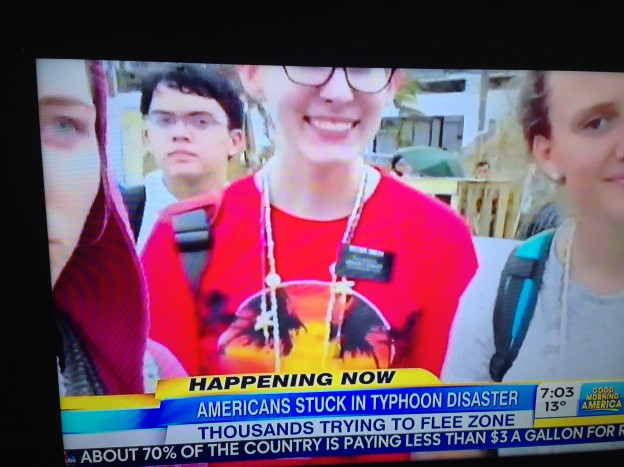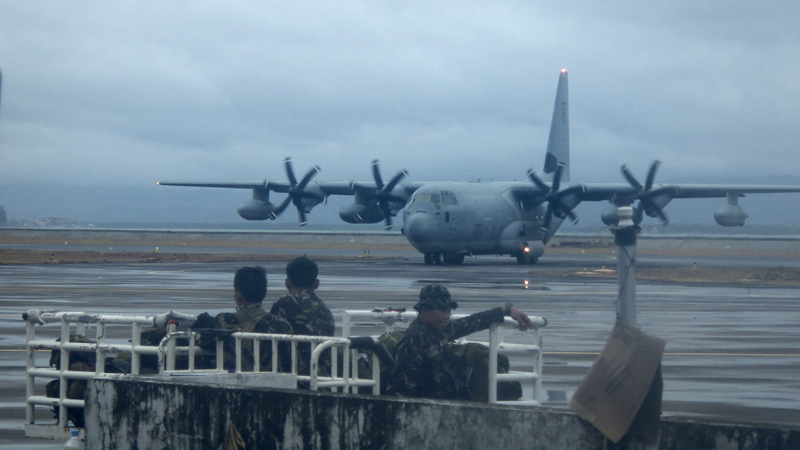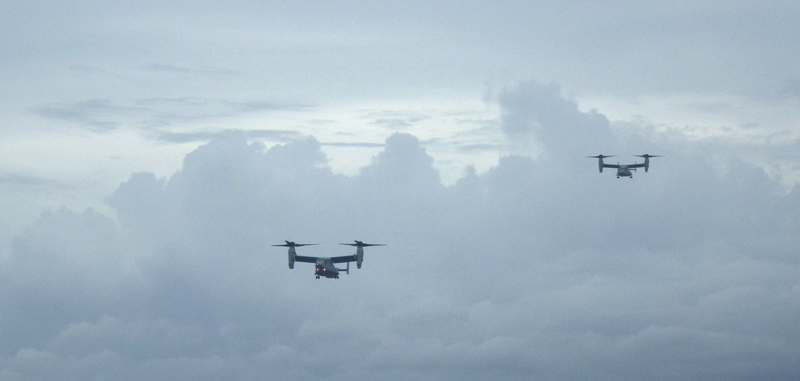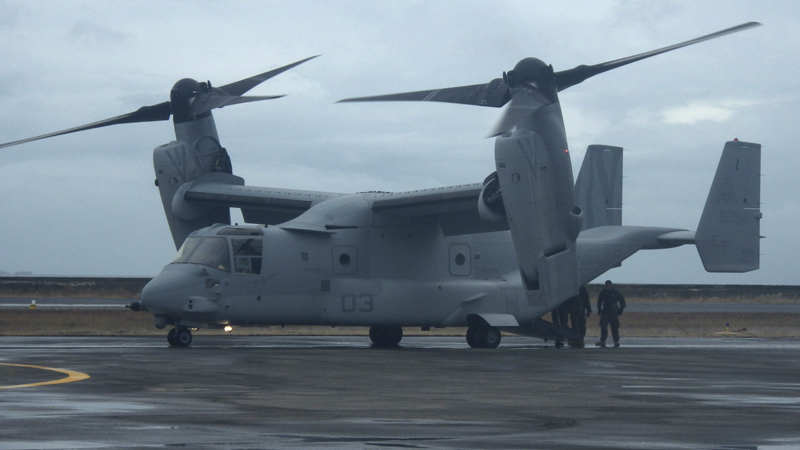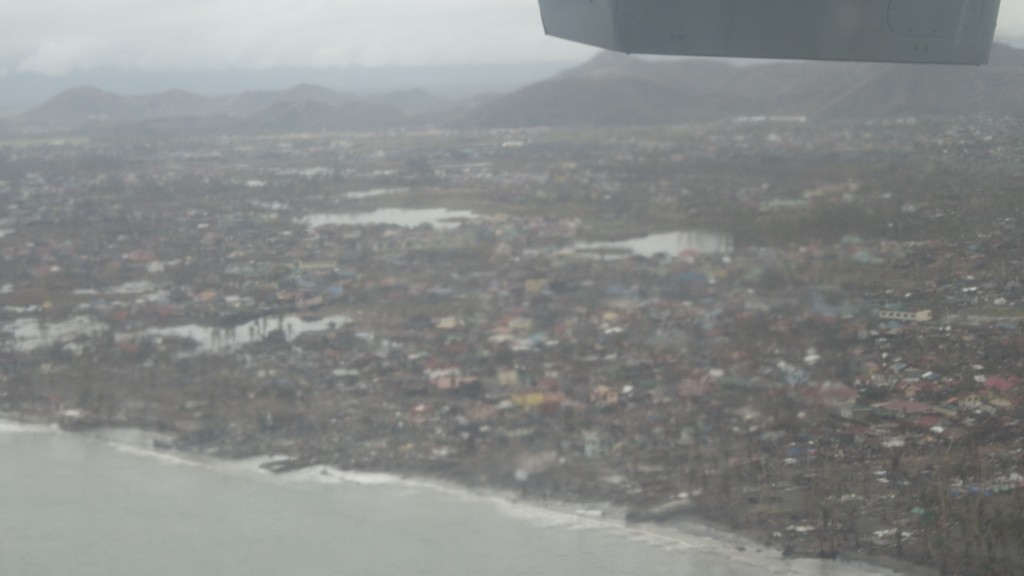Tuesday, November 12, 2013 — continued:
As the day drew on, a large part of our group migrated to a section of the airport where we could sit down between the partitions that were separating the queues for Philippine Airlines and Cebu Pacific Airlines.
While we were waiting there, I went to where there was an opening onto the tarmac and watched the airplanes come and go. While I was standing there, I was approached by Sergeant Clark from the tarmac. He told me that there was going to be five American C-130 flights in and out of the airport that afternoon. He said he could get us on whichever plane we wanted, but here also there was a catch. Because of political complications, they had not yet received clearance to evacuate Filipinos, but only US citizens and other foreigners.
I called out to President Maxfield, the first counselor in the mission presidency so that he could speak with Sergeant Clark about the matter. President Maxfield showed great concern about not being able to evacuate the native missionaries on the American C-130’s, but recognized that by putting most of us on the C-130, the plane that had been chartered earlier would probably be able to shuttle out the rest of the missionaries before the end of the day. Furthermore, Sergeant Clark was confident that they would be able to receive clearance to evacuate the Filipinos before the last flight left. Meanwhile, we needed to take an inventory of all of the missionaries at the airport by nationality.
Taking the inventory turned out to be quite difficult since there was no where we could all line up. Elder Mcguire, the supply manager, ended up counting all of the missionaries by having us all stand and then sit down when we were counted. To make sure that we were all on the list, we lined up next to the tarmac and left the building onto the tarmac only when our names were read from the list. Anyone that was left over could then be added to the list.
By the time we had all gotten onto the tarmac, two of the C-130’s had already come and gone. When the third arrived, another group of evacuees asked if they could get on ahead of us, and we decided to let them as long as we would be sure we were able to get on the next one. At this point, we also got the news that the US military had received clearance to evacuate the Filipino Missionaries.
There was a fair amount of media present at the airport, I guess they were all of the less-adventurous reporters that didn’t think it was necessary to leave the airport they landed at in order to get some good footage or pictures for a little story. It was at this time when a video was shot that would later be aired on Good Morning America.
After waiting longer than expected for the next C-130, Sergeant Clark joked that the Air Force wasn’t exactly known for its punctuality. After a few more minutes, we saw two helicopters coming in towards the runway in the distance. As they came closer, it became clear that they were not just any helicopters, but they were US Marines tilt-rotor V-22 Ospreys.
They were the first I had ever seen in flight, and as they came in to land, I was only more impressed. Landing like an airplane in slow-motion, rather than straight down, they landed one right behind the other on the runway and taxied over onto the tarmac.
Watching as they unloaded some supplies from each aircraft, I decided it was definitely wishful thinking to hope that they might be evacuating anyone on them. That is until we were told by one of the members of the US Special Forces team that we were going to be flying out on them. At first I thought he was joking, but Sergeant Clark confirmed, saying that we were super lucky. After eight years in the armed forces, he had still never gotten to ride in a V-22 Osprey.
We all lined up and followed one of the servicemen up to the first Osprey. The rotors were still spinning, and the wind behind the aircraft was so strong that it was difficult to walk as we approached the cargo door in the rear.
We filed in, setting our bags on the ground in between the two benches that ran along the sides of the interior of the aircraft. After securing our bags with a strap that buckled into the floor, some life-vest sort of item was passed out, but only to one side of the airplane. I wasn’t sure if I should be concerned that I wasn’t getting one, but with or without emergency equipment, the flight on the Osprey was going to be worth it. The turboprops were extremely loud, and we weren’t provided with hearing protection, but again, I would rather ride an Osprey without earplugs than miss the opportunity entirely.
The excitement continued to build as we taxied over to the runway, but I never could have anticipated how hard the V-22 was capable of taking off. We soared up into the air at a very steep angle, faster than I thought was possible for a vertical takeoff.
The flight was exhilarating. Pausing only once for a somber moment of taking pictures of downtown Tacloban out of the window I had conveniently been seated next to, flying in the Osprey was a completely different experience than that of commercial flight. Instead of being flown as gently as possible for as uneventful a flight as possible, the only limitation on this flight was the pilot’s personal restraint in showing us all the V-22 could do.
After about 5 minutes in flight, the pilot tilted the aircraft into an incredibly tight banking maneuver, until we were almost completely sideways, but pinned in our seats by the g-forces of the tight turn. I completely lost my sense of direction in the turn, as it seemed like we had turned further than a full 360 degrees.
We were all suddenly very surprised to find that we were already landing again as we saw a runway stretch out below as we descended back to the ground. We were all even more surprised to see that we had just landed at the Tacloban airport. When we landed, we were able to see that the fourth C-130 had landed and the Filipino missionaries were lined up to get on it.
After taking off again, I was startled to see that we were flying alongside the other Osprey out of the window across from my seat, and then even more startled to see out the front of the aircraft that we were flying right behind the C-130. They were going to be refueling in the air with us on board. Flying much closer to the C-130 than I thought was possible, our pilot guided the nose of the aircraft up to the end of a fuel line that was extending from a large tank attached to a pylon on the left wing of the C-130.
Once the refueling was complete, the three aircraft spread out and continued the rest of an uneventful flight to Manila.
When we arrived over Manila, the crew member in the back of the Osprey lowered the cargo door so that we could see out. With the sun low in the west, all of Manila bay shimmered brightly, filling the cabin with warm, golden light. Now safely in Manila, our experience in super typhoon Haiyan was over. Leaving the typhoon and all of the death, destruction, and fear that it had brought with it behind, we were all very relieved to be out of there.
